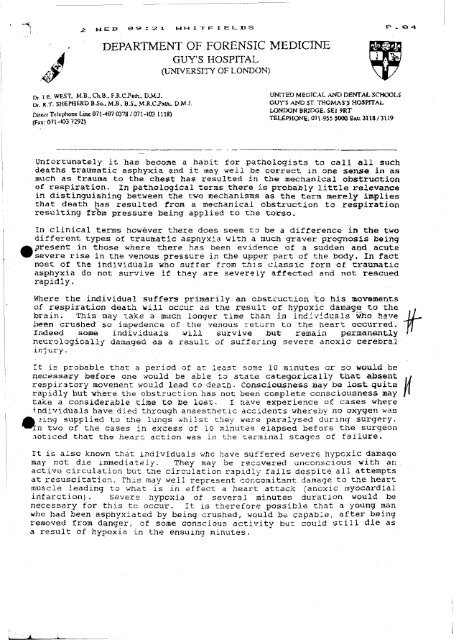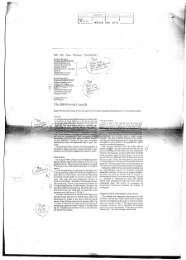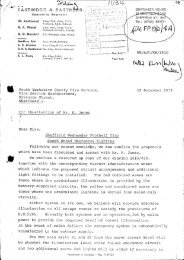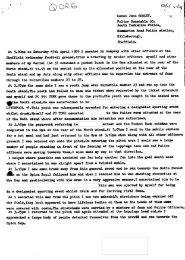DEPARTMENT OF FORENSIC MEDICINE - Hillsborough ...
DEPARTMENT OF FORENSIC MEDICINE - Hillsborough ...
DEPARTMENT OF FORENSIC MEDICINE - Hillsborough ...
You also want an ePaper? Increase the reach of your titles
YUMPU automatically turns print PDFs into web optimized ePapers that Google loves.
. w<br />
£ WED 0 -3 S 2 1 WHITFIELDS<br />
<strong>DEPARTMENT</strong> <strong>OF</strong> <strong>FORENSIC</strong> <strong>MEDICINE</strong><br />
GUY’S HOSPITAL<br />
(UNIVERSITY <strong>OF</strong> LONDON)<br />
O, i e . WEST. M.B., CUJB.. F.R.C.Pith., D.MJ.<br />
Dr- R.T. SHEPHERD B-Sc,. M-8.. B.S_ MR.C.P«h.. D M X<br />
D if act Telephone tine 07M 0? 037g /0 7 l-i0 3 1118)<br />
(F«: 071-103 7292)<br />
UNITED MEDICAL AND DENTAL SCHOOl-S<br />
GUTS AND ST. THOMAS'S HOSPITAL<br />
LONDON BRIDGE. SEl 9RT<br />
TELEPHONE. 011-955 5000 Ext: 3118/3119<br />
Unfortunately it has become a habit for pathologists to call all such<br />
deaths traumatic asphyxia and it may well be correct in one sense in as<br />
much as trauma to the chest has resulted in the mechanical obstruction<br />
of respiration- In pathological terms there is probably little relevance<br />
in distinguishing between the two mechanisms as the term merely implies<br />
that death has resulted from a mechanical obstruction to respiration<br />
resulting from pressure being applied to the torso.<br />
In clinical terms however there does seem to be a difference in the two<br />
different types of traumatic asphyxia with a much graver prognosis being<br />
•<br />
present in those where there has been evidence of a sudden and acute<br />
severe rise in the venous pressure in the upper part of the body. In fact<br />
most of the individuals who suffer from this classic form of traumatic<br />
asphyxia do not survive if they are severely affected and not rescued<br />
rapidly.<br />
R . G> -•»<br />
where the individual suffers primarily an obstruction to his movements<br />
of respiration death will occur as the result of hypoxic damage to the<br />
brain. This may take a much longer time than in individuals who have J,<br />
}?een crushed so impedence of the venous return to the heart occurred, yi<br />
Indeed some individuals will survive but remain permanently r<br />
neurologically damaged as a result of suffering severe anoxic cerebral<br />
injury.<br />
It is probable that a period of at least some 10 minutes or so would be<br />
necessary before one would be able to state categorically that absent .#<br />
respiratory movement would lead to death- Consciousness may be lost quite LJ<br />
rapidly but where the obstruction has not been complete consciousness may /»<br />
take a considerable time to be lost. I have experience of cases where<br />
individuals have died through anaesthetic accidents whereby no oxygen was<br />
zin g supplied to the lungs whilst they were paralysed during surgery,<br />
two of the cases in e x c e s s of 10 minutes elapsed before the surgeon<br />
noticed that the heart action was in the terminal stages of failure.<br />
It is also known that individuals who have suffered severe hypcxic damage<br />
may not die immediately. They may be recovered unconscious with an<br />
active circulation but the circulation rapidly fails despite all attempts<br />
at x’esuscitation. This roav well represent concomitant damage to the heart<br />
muscle leading to what is in effect a heart attack (anoxic myocardial<br />
infarction). severe hypoxia of several minutes duration would be<br />
necessary for this tc occur- It is therefore possible that a young man<br />
who had been asphyxiated by being crushed, would be capable, after being<br />
removed from danger, of some conscious activity but could still die as<br />
a result of hypoxia in the ensuing minutes.
















